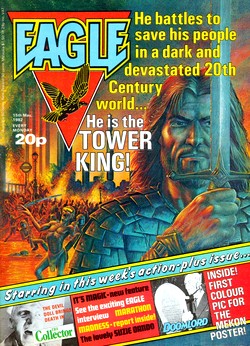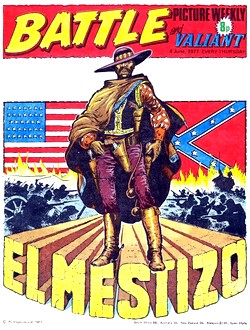
Battle Picture Weekly was a British weekly boys' war comic published by IPC Magazines from 8 March 1975 to 23 January 1988, when it merged with the new incarnation of Eagle after 644 issues. Most stories were set in World War II, with some based on other conflicts, while factual features also focused on warfare.

Starlord was a British weekly boys' science fiction comic published by IPC Magazines from 13 May to 7 October 1978, when it merged with 2000 AD after 22 issues. The comic was created by Kelvin Gosnell, and was originally intended as a fortnightly sister title for 2000 AD with higher production values and an older audience, but late changes in production saw it converted into a weekly.

"The Thirteenth Floor" is a British science fiction strip character, appearing in titles published by IPC Magazines. The strip debuted in the weekly anthology Scream! on 24 March 1984, before continuing in Eagle until 28 February 1987. The stories were written by John Wagner and Alan Grant; art was provided by José Ortiz. Since 2016 the property has been owned by Rebellion Developments, who have revived the strip in several specials. The plot was set in a tower block called Maxwell Tower, controlled by an experimental sentient computer called Max located on the 13th floor of the flats. Max himself narrated the strip, and as befitting a computerised custodian of hundreds of people, was quite chatty and light-hearted. However, he was also portrayed as having a programming flaw; programmed to love and protect his tenants, he could remorselessly kill anyone who threatened or even just annoyed them.

Doomlord is a British comic character, appearing in strips published by IPC Magazines. The character featured in British comic stories published in the weekly anthology Eagle from 27 March 1982 to 14 October 1989. The strip was initially a photo comic written by Alan Grant and John Wagner as Eagle experimented with the format. While "Doomlord" was popular with the readership, the photo stories had a more mixed reception, and from 24 September 1983 "Doomlord" turned into a conventional picture strip, with art from Eric Bradbury, and would run until October 1989. The story began with a Doomlord - a powerful alien - judging the human race's right to exist. Over the course of the strip three different Doomlords - Zyn, Vek, and Enok - would act as protagonist.

"The Tower King" is a British comic strip, appearing in titles published by IPC Magazines. The story was published in the anthology Eagle from 27 March to 4 September 1982, written by Alan Hebden, with art by José Ortiz. The story was set in a dystopian London, where society has broken down.

Tornado was a British weekly boys' adventure comic published by IPC Magazines from 24 March to 18 August 1979. The comic was partly created as a way to use up stories already commissioned for the other titles, and was marred by a difficult production. Tornado sold poorly and was merged with 2000 AD after 22 issues.

"The House of Dolmann" is a British comic strip published by Fleetway Publications and later IPC Magazines in the boys' comic anthology title Valiant between 29 October 1966 to 11 April 1970, with a brief revival from 7 September to 26 October 1974. Written by Tom Tully and primarily illustrated by Eric Bradbury, the strip centred on the exploits of genius inventor Eric Dolmann and his army of crime-fighting robot 'puppets'.

Eric Bradbury was a British comic artist who primarily worked for Amalgamated Press/IPC from the late 1940s to the 1990s.

Major Eazy is a British comic character, appearing in strips published by IPC Magazines. Eazy featured British comic war stories published in the weekly anthology Battle Picture Weekly from 10 January 1976 to 10 June 1978, written by Alan Hebden and drawn by Carlos Ezquerra. Set during World War II, the strips follow Eazy, an unconventional British Army officer with a laidback attitude.

"The Dracula File" is a British comic horror strip published by IPC Magazines and Rebellion Developments. It debuted in the first issue of the weekly anthology comic Scream on 24 March 1984. The story was written by Gerry Finley-Day and later Simon Furman, and was drawn by Eric Bradbury. The story featured Count Dracula escaping from the Eastern Bloc at the height of the Cold War before appearing in modern-day England, with KGB Colonel Stakis in pursuit. Scream was short-lived, being merged into Eagle in June 1984 after only 15 issues.

"Hellman of Hammer Force" is a British comic strip published by IPC Magazines in the boys' comic anthology titles Action and later Battle between 14 February 1976 and 8 July 1978. The story was set in World War II; while war comics were common material in British comics of the time, "Hellman of Hammer Force" was rare for its use of a sympathetic Wehrmacht officer as the lead protagonist. While not as controversial as fellow Action stories such as "Kids Rule O.K." and "Hookjaw" it was nevertheless caught up in the campaign against the title by the British tabloid press.

"Invasion 1984!" is a British comic strip published by IPC Magazines in the boys' comic anthology title Battle between 26 March and 31 December 1983. Written by John Wagner and Alan Grant, and drawn by Eric Bradbury, the story depicts an alien invasion of a very near future Earth by advanced, brutal aliens referred to only as 'Spooks'.

"D-Day Dawson" is a British comic war story published in the weekly anthology Battle Picture Weekly from 8 March 1975 to 22 January 1977 by IPC Magazines. Set during World War II, the story follows Steve Dawson, a sergeant in the British Army left with an inoperable bullet next to his heart after being shot during the D-Day landings.

"The Bootneck Boy" is a British comic war story published in the weekly anthology Battle Picture Weekly from 8 March 1975 to 12 November 1977 by IPC Magazines. Set during World War II, the story follows Danny Budd, a youth from the fictional Northern England town of Tynecastle as he strives to join the Royal Marines.

"Clash of the Guards" is a British comic war story published in the weekly anthology Battle from 26 September 1981 to 23 April 1983 by IPC Magazines. Set during World War II, it follows the experiences of Brad Clash, a fictional American stuntman turned 6th Corps soldier assigned to pick up tips from a company of British Guards in Italy.

"El Mestizo" is a British comic war story published in the weekly anthology Battle Picture Weekly from 4 June to 17 September 1977 by IPC Magazines. Set during the American Civil War, the story follows a mestizo slave turned mercenary returning from Mexico to America in 1862. The story was written by Alan Hebden and drawn by Carlos Ezquerra.

"Rat Pack" is a British comic war story published in the weekly anthology Battle Picture Weekly from 8 March 1975 to 8 July 1978 by IPC Magazines. Set during World War II, the story follows the eponymous unit, a penal military unit of four criminals recruited by British Army officer Major Taggart to undertake deadly missions.

"Mind Wars" is a British comic science fiction adventure story published in the weekly anthology Starlord from 20 May to 7 October 1978 by IPC Magazines.

Eagle, sometimes referred to as The New Eagle and known at various points in its life as Eagle and Scream!, Eagle and Tiger, Eagle and Battle, Eagle and M.A.S.K. and Eagle and Wildcat, was a British boys' adventure comic published by IPC Magazines from 27 March 1982 to January 1994. A revival of the famous Eagle, the title was initially a weekly publication until turning into a monthly in May 1991. The title was finally cancelled in January 1994, after 505 issues.



















